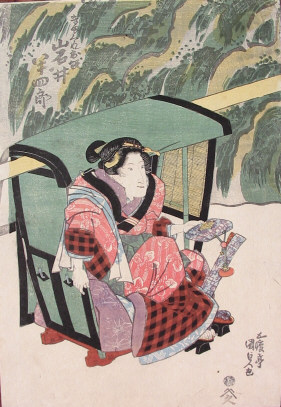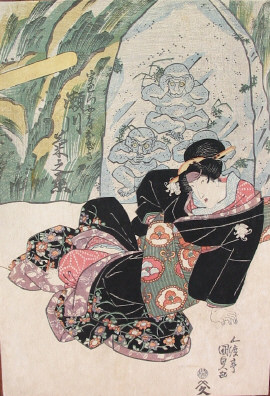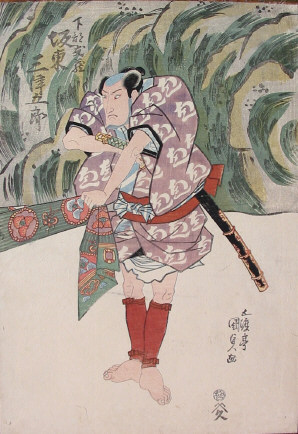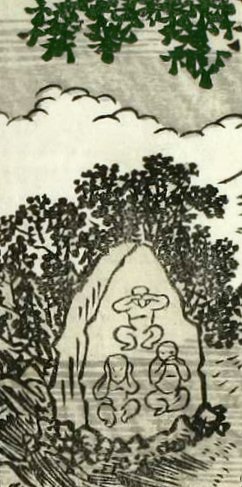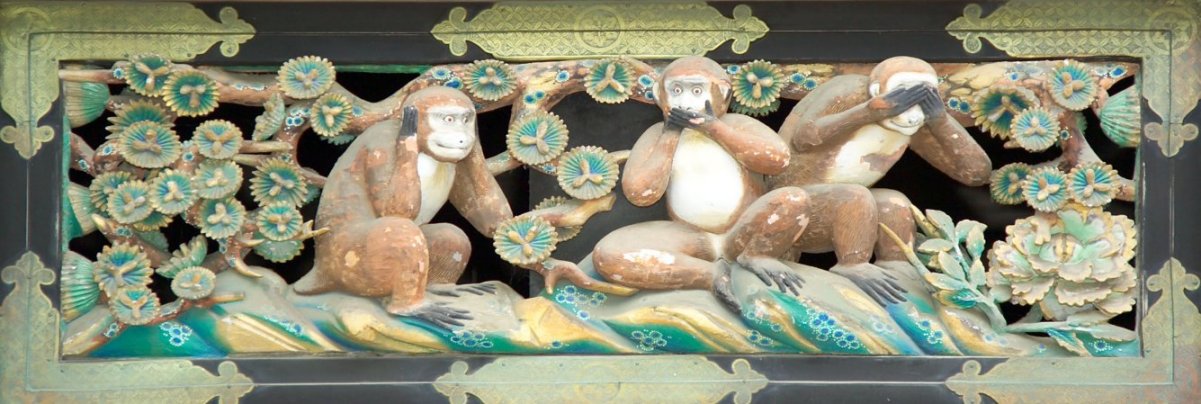 |
JAPANESE PRINTS
A MILLION QUESTIONS
TWO MILLION MYSTERIES
Ukiyo-e Prints浮世絵版画 |
| Port Townsend, Washington |
|
UTAGAWA KUNISADA 歌川国貞 うたがわくにさだ 1786-1865 |
|
Actors |
|
Left Panel: Iwai Hanshirō V as Kimagure Osaka 岩井半四郎 いわいはんしろう |
|
Center Panel: Segawa Kikunojō V as Jitsuemon Nyobo Ogisa 瀬川菊之丞 (?) せがわきくのじょう (?) |
|
Right Panel: Bando Mitsugorō III as Kabu Tomozo 坂東三津五郎 ばんどうみつごろう |
|
Publisher: Eikyūdō (Yamamoto-ya Heikichi) |
|
Date: 9/1825 |
| Total Size: 14 3/4" x 30" |
|
There is a copy of this triptych in the Victoria and Albert Museum. They identify the play as Toki ni uttari oyatsu no taiko. |
|
ORIGINALLY $720.00 NOW $432.00 SOLD! |
|
|
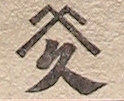 |
||||
| Publisher: Eikyūdō | ||||
|
WHAT IS THE KŌSHIN-TO? 庚申と こうしんと
|
|
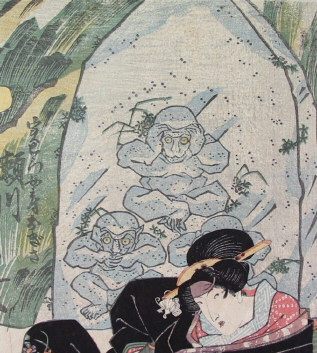 |
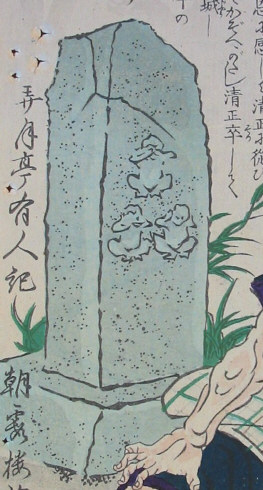 |
|
|
|
|
In ancient Greece and Rome there were boundary markers which we know of as 'terms' or 'herms'. They were stone pillars often topped off with the head of the god Terminus or Hermes and with no other adornment than an erect phallus prominently featured. In Roman mythology Terminus was the god of boundaries and landmarks. As such these markers played a religious or quasi-religious role.
Although I can not imagine that there is any possible direct connection between the carved stone tablets known as kōshinzuka (庚申塚 or こうしんずか) which marked the boundaries between villages in Japan and the terminus markers used in Greece and Rome there may have been a very tenuous link via an ancient Indian/Chinese connection. This should be resolvable by tracing back to the earliest such stone markers and seeing whether they were in use in this form prior to the introduction of Buddhism into Japan. |
|
|
"BY THE VILLAGE road, and more often at the dividing line between two villages there stands a koshin-zuka or a koshin stone tablet.... As it usually stands on a village road, it is regarded as the guardian of the road or the protector of travellers. But originally it was the guardian deity for the local people." According to Mock Joya the Buddhist priest Dengyo (767-822) engraved a kōshin tablet with three monkeys, a motif he had brought from China. If this is true it would have married a local tradition with a new one motif. |
|
|
SEE NO EVIL, HEAR NO EVIL AND SPEAK NO EVIL 見猿聞か猿言わ猿 みざるきかざるいわざる |
|
|
SHINTAI
If I understand it correctly a koshinzuka is a shintai, i.e., an object in which the spirit of a kami or god resides. Therefore the stone markers found along the roads were there to act as protectors of travelers.
Brian Bocking in his A Popular Dictionary of Shinto (NTC Publishing Group, 1997, p. 172) state that shintai are "Kami-body, sacred substance. An object in which the kami inheres. A term best left untranslated, shintai is respectfully referred to as go-shintai or in 'Japanese' reading mi-tama-shiro or yori-shiro. A shintai may be a natural feature such as a rock, tree, mountain...volcano crater, waterfall, or well or it may be a manufactured object such as a mirror, sword, painting..." etc. |
|
|
|
Here is a third example of a stone marker with the three monkeys. This one is from an ehon illustrated by Toyokuni I from the first years of the 19th century. In the full page the monkeys are at one end of a bridge. Nearby is a shrine or temple with a row of six stone images of Jizō (?). |
|
|
THE THREE WISE MONKEYS |
||
|
MIZARU |
||
|
|
三猿 |
|
|
|
みざる
|
|
|
見猿 |
|
言わ猿 |
|
みざる |
言か猿 |
いわざる |
|
mizaru |
||
|
SEE-NOT MONKEY |
きかざる |
iwazaru |
|
|
kikazaru |
SPEAK-NOT MONKEY |
|
|
HEAR-NOT MONKEY |
|
 HOME
HOME
